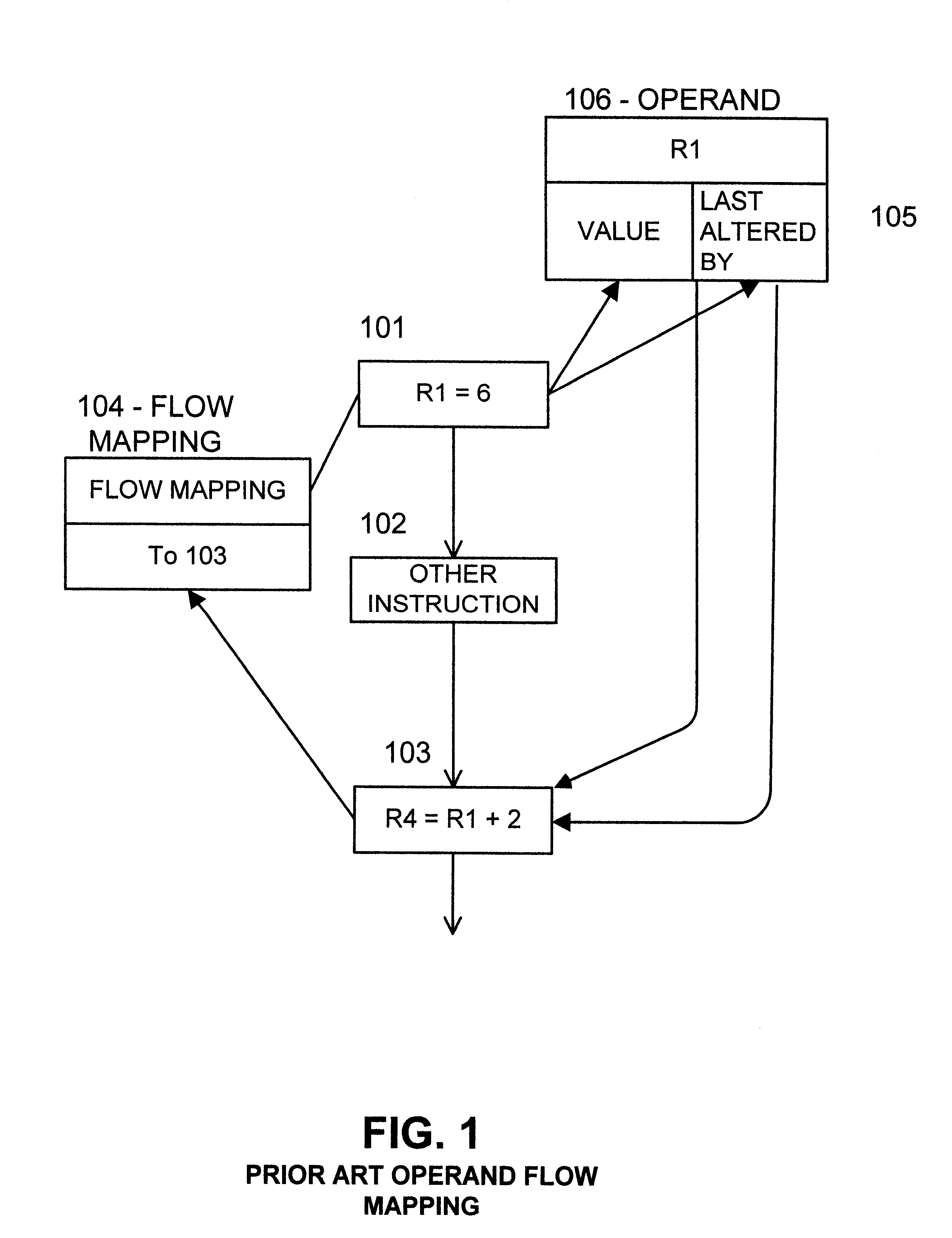These prior art computer processors fail to gather much information about operands and the flow of operand values and then discard all or most of the information they do gather.
To manage more in-process instructions requires larger windows of instructions from which to choose and the complexity of larger windows increases faster than increases in window size.
Among the most severe barriers to increasing the number of instructions executed per
clock cycle is multiporting of operand storage.
Unfortunately, the number of components required to construct access ports grows much faster than the number of ports supplied.
Increasing the number of ports is also likely to increase the
access time to the operand storage being ported.
The
machine will, at times, execute down the wrong path of instructions and have to abandon some of its results.
None of the above methods provides means to classify operands by use (load vs. store) nor by time proximity of next use.
With no means of classification there can be no optimization of operand forwarding or storage.
Storing operands in only one or two possible, Centralized storage structures will lead to bottlenecks as computer designers attempt to scale to much higher instruction issue and retirement rates.
Scaling instruction rates with centralized storage structures requires increasingly more ports into those storage structures and such centralized storage cannot be distributed among multiple, loosely connected execution or retirement units.
These methods are not scalable to large numbers of execution units because the cache structures are centralized--large numbers of execution units accessing the same centralized cache stores would require non-scalable degrees of read and write multiporting.
In this case, remembering the most recent
synonym for the static dependence is not sufficient.
None of the documents referenced above teach any means to map such inter-loop flows or any way to
exploit such flows at
execution time.
It is a problem in SMP computer systems to keep the private caches coherent so that all processors will see a unique memory location as having the same value.
This problem is complicated by executing memory access (load or store) instructions speculatively before it is known whether the
branch paths leading to those memory access instructions will actually be followed.
It could be very inappropriate for a speculative load or
store instruction to send
cache coherence signals to other processors when a
branch leading to that instruction might have been mispredicted so that the instruction's execution will have to be nullified.
It would be even more problematic if a synchronization instruction, like
Compare And Swap were speculatively executed and affected execution in one of the other memory coupled processors.
The latter problem would lead to incorrect operation.
Speculative execution of loads and stores to memory areas that could contain operands shared across CPUs requires facilities missing from current computer designs.
Branch prediction has been improved to the point of being very accurate, but not perfect.
However, today's processor microarchitectures could not accommodate such high levels of instruction parallelism because they must single thread the updates to such a stack pointer.
Several PEs could share a single transient value cache but the quickly increasing cost and operating
delay of multiporting to
handle simultaneous access by an increasing number of PEs will require splitting the transient value cache as shown in FIG. 5 where no more than two PEs share access to any single transient value cache.
If the target instruction is far removed from the source then there may be a considerable time lapse between the anticipatory execution of the target and a use for its output or action.
If the target instruction requires other inputs then there can be a long wait, of many
clock cycles for arrival of the other operands.
Where operands will not be needed for many cycles but have been forwarded to an
execution unit, those operands will needlessly occupy storage in those units.
Due to costs of value propagation, designers would favor such replication only for operands whose values are seldom changed.
Capturing operand flows without explicit operand
annotation allows application of many of the enhancements of the present invention but the operand flows involved are limited to instructions that execute together in the same window with the further limitation that the flow target instructions obtain their input operands from renamed computations instead of from architected locations such as register files or data caches that are not annotated with instruction sources.
It is not sufficient to merely load a memory lock word to ensure that some other thread has not reserved it.
The processor's faster local cache cannot be used for
spin locks.
It is difficult to design a processor so that
Compare And Swap can be executed speculatively since it causes an action to main memory that might cause another processor to enter a
spin lock loop when it could turn out that the program in the first processor actually followed a prior branch path that was mispredicted so that the first processor should never affect the
spin lock.
This insurance is expensive because the spin lock cannot be accessed in fast, private cache but requires a high latency access to main memory.
One of the expensive aspects of a spin lock is when there is contention.
A losing processor will spin in a tight loop, accomplishing nothing.
Processors also often wait for
long latency operations such as accesses to main memory.
 Login to View More
Login to View More  Login to View More
Login to View More 


